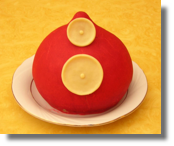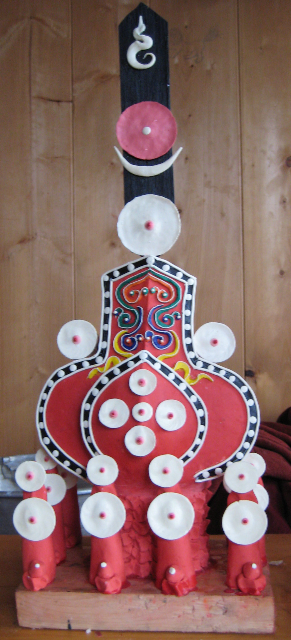Torma 食子 / 朵瑪
Torma (Wyl. gtor ma; Skt. baliṃta) — a ritual cake, usually hand-moulded from butter and tsampa (roasted barley flour) and coloured with dyes, which can symbolize a deity, a mandala, an offering, or even a weapon.
More 'permanent' tormas can be made of clay or plasticine, to which small amounts of edible substances such as düdtsi are added when they are made. Tormas are usually ornamented with kargyen, 'white ornament', which are disc-like decorations of the sun and moon, four-petalled flowers, lotus bases and dissolving-point shapes known as nada.
Origin
To trace back a particular practice or aspect of practice to the Buddha is a way to authenticate its origin, while showing that the lineage has remained uninterrupted since its inception helps give us confidence that the way we are practising today is still in accordance with the instructions of the Buddha.
The origin of the tormas we offer is described in the following account. Once, at the time of the Buddha Shakyamuni, as Ananda was practising the Dharma in the forest near the city of Kapilavastu, a frightening preta spitting fire through his mouth appeared in front of him. He told Ananda, “You have only seven days left to live, at the end of which I will eat you.” Ananda, extremely scared, ran to the Buddha and told him what had just happened. The Bhagavan replied, “Make a torma of infinite magnificence, bless it with mantra, and offer it. This will liberate you from the fear of untimely death and lead you to accomplish infinite qualities.”
Transmission Lineage
The practice of offering torma has been transmitted through many lineages, but one particular lineage is as follows: Ananda transmitted to Nanda, and Nanda to the bhikshuni Rati. Several arhats received it from her and then passed it on to the yogin Antavajra, and the sages of Bodhgaya. Then it passed to Dharmamati, Atisha, Dromtönpa who, in turn, transmitted it to the Three Brothers (his three principal disciples—Potowa, Chengawa and Phuchungwa). This is how the lineage was transmitted progressively to Tibet, the Land of Snows.
The Essence of Torma
The essence of the torma is the dharmadhatu, which is the utterly pure nature of the world, and the wisdom of rigpa, the completely pure nature of the sentient beings inhabiting the world—it is the indivisible union of emptiness (the object) and wisdom (the subject).
Even though there are several categories of tormas (such as outer, inner, secret, dhyana, illustrative) here we are mainly discussing the first, the outer torma.
Meaning of the Word

As for the term ‘torma’, Guru Padmasambhava said:
- ‘tor’ means to give without attachment, and
- ‘ma’ means completely present.
So ‘tor’ refers to giving without any attachment or grasping in the mind, and ‘ma’ to when what is given is completely present to the perception of the guests.
And who are those guests? In a nutshell they are those who are higher than us and to whom we offer, and those who are lower than us and to whom we give. To divide those two groups slightly, there are four categories:
- the guests invited out of respect, the Three Jewels,
- the guests invited for their qualities, the glorious deities,
- the guests invited out of compassion, the beings of the six realms, and
- the guests who are harmful spirits (Tib. dön), obstacle makers (Tib. gek) and our karmic creditors.
Further Reading
- Padmasambhava and Jamgön Kongtrül, The Light of Wisdom, Vol II, translated by Erik Pema Kunsang (Boudhanath, Hong Kong & Esby: Rangjung Yeshe, 1998), pages 128-129 & 199-200.
